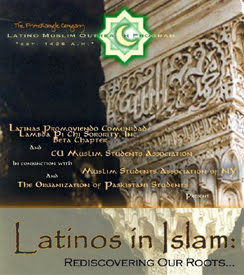By Susy Tekunan VOA Indonesia Two reporters of VOA Indonesia met with LADO sisters on October 7, 2005. It was during Ramadhan, and the sisters were having an Iftar Dinner at one of the sister’s house. We conducted an interview with some members but mostly with Zulayka Martinez who we think could represent the group with her story as the only Muslim in her family. Before the day of this event, we visited with brother Mujahid and his family at his residence to speak with him about how his life changed after he became a Muslim. Mujahid, his wife, and
Read MoreBy Shafiq (Juan) Alvarado Brief History of Spanish The Spanish language has a fascinating history. Having evolved in the Iberian Peninsula, Spanish is now spoken by an estimated 332 million people in about 20 countries and within many other countries. Because very many people in many countries speak it, Spanish was chosen as one of the representative languages of the United Nations. Another result is a natural variation has evolved in all of the countries and regions. For example, Spanish words, slang, and dialect may vary within a particular country or region. Spanish evolved out of ‘vulgar Latin’ or the
Read MoreBy Shaikh Yahya Suquillo Islamic Values Already Present in Latin American Culture Measuring Latin American culture in terms of the development of Islamic cultural values is difficult except for a few aspects. One reason for the unawareness of Islamic cultural values present in Latin American culture is an educational system that does not mention that Islamic values influenced Latin American culture during centuries of Islam’s existence within the Spanish culture. Consider the great Islamic architecture within some cities in South America. In Brazil, for instance, some old churches are decorated with Arabic calligraphy art carved by Muslim slaves that were
Read MoreBy Maria Enriqueta Romero Asalaam alaikum, When I first moved to Seattle, Washington, I didn’t know anyone. When I attended jumah, no one would give me salaams (a personal pet peeve). Things began to change after I posted a message on a newslist, a Yahoogroup of all places. My message was a plea for guidance to local sisters. I didn’t specify Latino or anything like that. By the grace of Allah (swt), one sister guided me to another sister. This sister would lead me to the women that are my sisters today. Among them is one Mexican sister with three
Read MoreBy Cara Karema Harpole November 17, 2005 Asalaam alaikum, Recent update: FEMA has decided to discontinue its payment of (Katrina victims) residents living in hotels in the Houston area on December 1st. There are now 19,000 New Orleans residents living in hotels. Because of FEMA’s non-payment to apartments who had initially accepted the vouchers, many complexes are refusing FEMA vouchers regardless of their previous policies. One complex is suing FEMA for payment after nearly three months of waiting. Residents (Muslims) in the Dallas area are continuing to move into Houston when they get word of the voucher program. Although things
Read MoreBy Khalid Malik Rosa My first Ramadan was a time of change for me. It would be the first time I engaged in the Islamic fast. Also, I would learn about how important Islam is to me in the face of societal criticism and ignorance. On a personal and practical level, I was also able to take time to figure out some important matters in my life. I decided to pursue a career in business instead of academia, which for me means pursuing an MBA rather than a PhD. It was a very tough decision; I am glad I had
Read MoreBy Nylka Vargas In the Name of Allah, Most Gracious, Most Merciful. The call to prayer; the savoring of fresh dates, then followed by Salaatul Maghrib at 6:30 p.m., the usual on a busy Ramadan evening. The Islamic Education Center of North Hudson (IECNH) has traditionally hosted weekend iftars for families, sponsored by donors early in the month. This year, however, a few of us Latinas thought it would be nice to sponsor a dinner ‘para la comunidad’. The iftar was our way of sharing the blessings of Ramadan with our local Muslim community, mostly Arab-speaking. Our local Muslim community
Read MoreBy Wendy Diaz-Guadalupe October 11, 2005 was a historical night in New York City where Muslims and non-Muslims came together as one entity to discuss untold events of Latino culture. Columbia University’s Muslim Students Association and Lamda Pi Chi Sorority, Inc., sponsored “Latinos in Islam: Rediscovering Our Roots.” The event was presented by Hernan Guadalupe of the Latino Muslim Outreach Program (L.M.O.P.), a program founded under the PrimeXample Company which aims to build relationships between non-Muslims and Muslims through Islamic awareness based on the Qur’an and Sunnah, or authentic traditions of the Prophet Muhammad, peace and blessings be upon him.
Read MoreBy IMANCentral For almost a year, Inner-City Muslim Action Network (IMAN) has actively mobilized around the issue of day labor in the Chicago land area. IMAN has created a network of trust and support among large circles, which includes Muslims and Latinos, through an issue that reaches the core of the inner-city community. The Challenge of the Day Laborer… Day laborers are workers who are employed on a task-by-task basis, and they are mainly immigrant men. Most day laborers are Mexican immigrants, while another’s tenth are from Central and South America. The majority are under 40 years of age. They
Read More“And whatever is in the heavens and whatever creature is in the earth submits humbly to Allah, and the angels too, and they are not proud.” – Quran 16:49. “Behold! In the creation of the heavens and the earth, and the alternation of night and day, – there are indeed Signs for men of understanding, – Men who celebrate the praises of God, standing, sitting, and lying down on their sides, and contemplate the (wonders of) creation in the heavens and the earth, (with the thought): ‘Our Lord! not for naught hast Thou created (all) this! Glory to Thee!’” –
Read More
